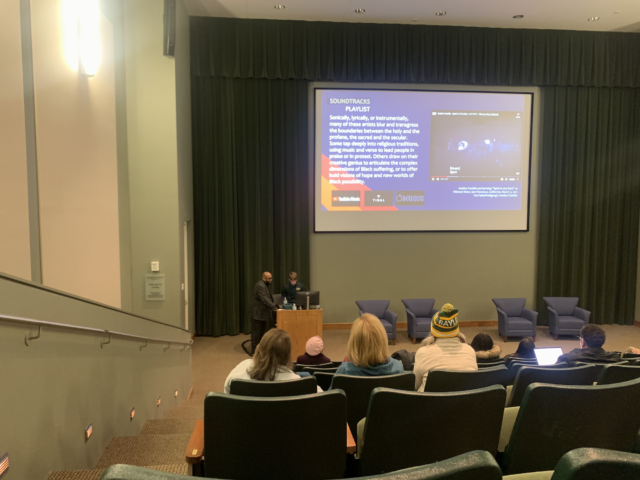By Sydney Kerbow | Reporter
On a cold Wednesday evening, Dr. Eric Williams captivated an eager audience at the Mayborn Museum with a lecture on his Smithsonian exhibition, “Spirit in the Dark: Religion in Black Music, Activism and Popular Culture.”
As the director of the office of Black church studies at Duke University Divinity School, Williams brought a wealth of knowledge and passion to his discussion, blending history, theology and cultural critique.
Williams began by highlighting the significance of the Johnson Publishing Company archive, which was acquired by Smithsonian in 2019 by major philanthropic organizations.
“This is the first exhibition that was culled out of all of these billions of images and files that was turned over,” Williams said, referencing the wealth of material sourced from “Negro Digest,” “Ebony” and “Jet” magazines.
The exhibition showcases 37 framed photographs from the archive and approximately 25 objects from the museum’s collection, according to Williams.
One of the central themes of “Spirit in the Dark” is the blending of the sacred and the secular in Black artistic expression. Williams illustrated this with an image of Marvin Gaye.
“Marvin Gaye was one of the architects of the Motown style, and in his music he often fused what many perceive as the sacred and the secular,” Williams said.
He pointed out the theological symbolism in Gaye’s attire, emphasizing that “the crowns signify that everything that they did was under God.”
The exhibition also explores the role of Black religious leaders in social activism. One of these who Williams highlighted was Mahalia Jackson.
“She led worship in church, but she also led in seasons of protest,” Williams said.
Williams recalled how Dr. Martin Luther King Jr. would call on Jackson for encouragement during civil rights demonstrations. Similarly, Malcolm X’s presence in the exhibit underscores his dual role as both a political and religious figure.
“Though we talk about [Malcom X] within the context of protest, he also is providing service to a religious community on a regular basis,” Williams said.
In the section on suffering and hope, Williams reflected on James Baldwin’s literary contributions.
“Baldwin –– through his pen –– helps us to understand the complexity of the ‘color conundrum,’ as he calls it, in America,” Williams said.
He also highlighted Maya Angelou’s creative process, revealing how her writing was deeply influenced by religious traditions.
“She has her Bible, she has her dictionary, she even has her cigarettes on the bed with her,” Williams said.
A particularly striking artifact in the exhibition is Little Richard’s personal Bible, which Williams described as a testament to the musician’s lifelong spiritual struggle.
“Even when the drugs were in control of him … he had some hope that God could rescue him from the danger in which he often found himself,” Williams said.
Williams concluded by emphasizing the exhibition’s accessibility, sharing that “Spirit in the Dark” is available online through the Smithsonian’s Searchable Museum, as well as through a specially curated soundtrack.
The lecture resonated with attendees, including Houston sophomore Hailey Ward, who reflected on the impact of “Spirit in the Dark.”
“I thought it was just a brilliant way to showcase different Black lives throughout America,” Ward said. ”It was really interesting seeing how [Williams] put together such an amazing showcase of work and art.”



